Longevity is not just about genetics or luck; it is about daily choices that significantly influence how long and well you live.
Exercises can strengthen your body, protect your heart, and sharpen your mind, creating a body that ages gracefully.
Harvard Health found that weightlifting and moderate-to-vigorous aerobic exercise reduced the risk of dying by 9-22%, and by 41-47% compared to no exercise.
Workouts can slow cellular aging, boost immunity, and enhance mental clarity. Different workouts target cardiovascular endurance, flexibility, and muscular strength, ensuring your body stays resilient against chronic diseases.
These longevity-focused workouts can be adapted for any lifestyle, making them a powerful longevity tool.
By choosing exercises that enhance physical performance and contribute to your lifespan, you can unlock a longer, more vibrant life.
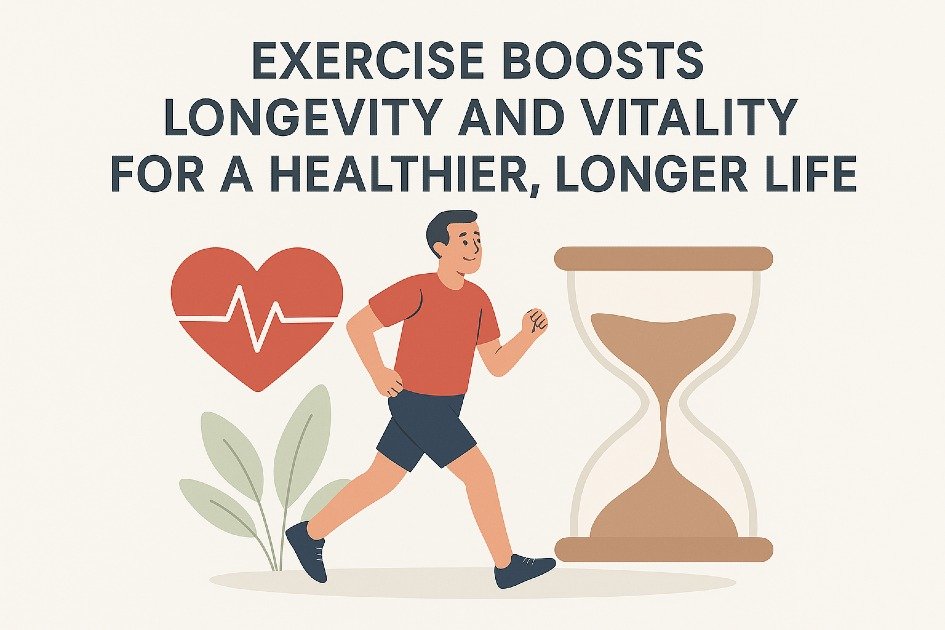
Why Exercise is Your Secret Weapon for Longevity
Exercise is a powerful tool for living a longer, healthier life, not just about weight loss or muscle building. Regular movement transforms health, making you feel younger, stronger, and more energetic.
How Consistent Movement Strengthens Your Heart and Lungs
Regular workouts can significantly improve cardiovascular efficiency, reducing the risk of heart disease, high blood pressure, and reduced lung capacity, thereby enhancing quality of life.
Engage in daily activities like walking, jogging, or cardio circuits for 20 minutes to boost heart rate, improve blood circulation, and strengthen lungs, reducing fatigue.
When I use my smart treadmill, I feel more energized and focused. The guided programs keep me motivated, making it the perfect home workout when I need support.
The Role of Exercise in Slowing Cellular Aging
Inactivity accelerates cell aging, leading to wrinkles, weak immunity, and chronic diseases. Exercises engaging in multiple muscle groups and stimulating blood flow can help combat this.
Strength training and cardio workouts are essential for maintaining muscle mass, slowing cellular decay, and boosting energy, as they help prevent muscle decline with age.
When I stick to a structured workout plan, I feel stronger, sharper, and more energized. It lowers my risk of age-related problems and helps me stay fit, healthy, and youthful.
Boosting Immunity Naturally Through Regular Activity
Workouts improve immunity by promoting efficient circulation and reducing stress hormones, thereby enhancing the body’s defenses against infections and inflammation, thus promoting longevity.
Moderate exercise, such as walking, cycling, or yoga, can maintain immune system alertness and responsiveness, but overtraining without recovery can suppress immunity.
When I stick to daily workouts, I rarely get sick, and even if I do, I bounce back quickly. Exercise helps me manage stress and adapt to changes, keeping me strong and healthy.
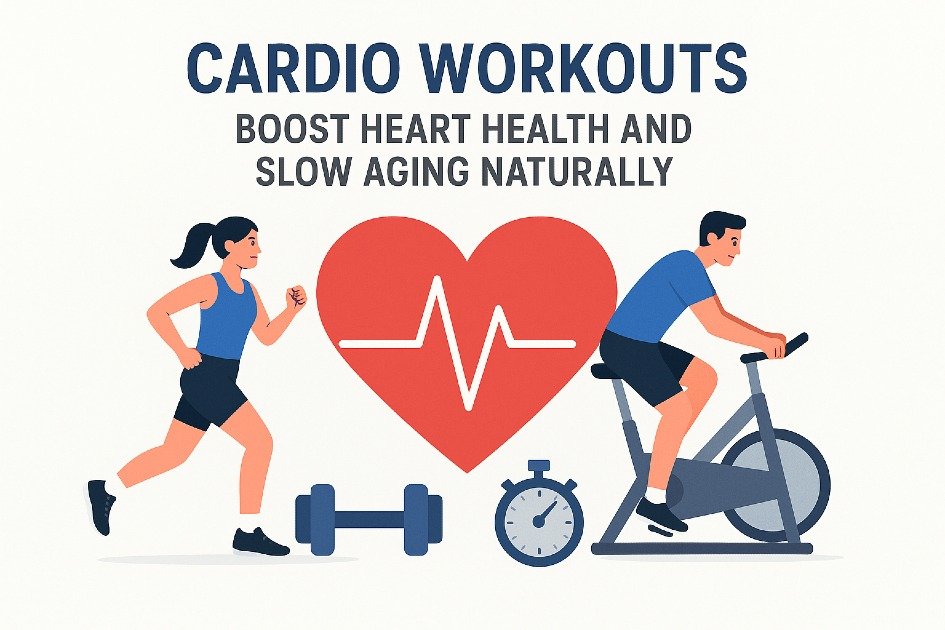
Cardio Workouts That Keep You Young
Cardio exercises extend lifespan by strengthening heart, lungs, and brain, and are essential for a healthier, more energetic life. Effective exercises include breaking down their importance and practical ways to perform them.
Walking and Hiking: The Underrated Longevity Boosters
Why it matters:
Regular walking, hiking, and gentle cardio can lower blood pressure, reduce heart disease risk, strengthen muscles, improve bone density, and support long-term health by reducing inflammation and maintaining a balanced mood.
How to do it:
- Do a brisk 20–30-minute walk at least five times a week.
- Walk on different surfaces to build balance and strengthen your legs.
- Hike with trekking poles to work your upper body.
- Take nature walks to stay active and reduce stress.
- Increase your speed or distance slowly to keep improving.
Jogging and Running: Longevity in Motion
Why it matters:
Running enhances cardiovascular efficiency, lung capacity, heart strength, and brain function, promoting healthy blood pressure and memory retention as you grow older.
How to do it:
- Start with interval jogging: jog for 1 minute, walk 2 minutes.
- Wear supportive shoes to protect your joints.
- Use a fitness watch or app to track progress and stay motivated.
- Increase your running time as you get stronger.
- Rest when your body needs it to prevent injuries.
Swimming: Full-Body Fitness Without Impact
Why it matters:
Swimming offers low-impact exercise, reducing joint stress and providing high cardiovascular benefits. It strengthens muscles, improves flexibility, and improves circulation, reducing chronic inflammation.
How to do it:
- Swim 2–3 times a week for 20–40 minutes each session.
- Swim different strokes—freestyle, breaststroke, and backstroke—to work all muscles.
- Do short sprints to raise your heart rate and speed up metabolism.
- Use a kickboard or pull buoy to target and strengthen specific muscles.
- Breathe deeply to build stronger lungs and better endurance.
Cycling: Boost Your Heart and Muscles
Why it matters:
Cycling enhances leg muscles, joint mobility, cardiovascular endurance, and vitamin D levels, while providing fresh air and sunlight, and is an enjoyable, low-impact activity that promotes consistency.
How to do it:
- Do 30-minute workouts, 3–4 times each week.
- Set your seat and handlebars to keep good posture and avoid strain.
- Add hill climbs or resistance to grow strength.
- Pedal at 60–80 rotations per minute for effective cardio.
- Add short sprints to cycling to burn more calories and strengthen your heart.
Dancing: Fun That Adds Years
Why it matters:
Dancing boosts heart rate, coordination, reduces stress hormones, keeps brain active, and improves flexibility and balance, lowering fall risk.
How to do it:
- Take a local dance class or learn online at home.
- Begin with 15–20 minutes and slowly build up to 45 minutes.
- Dance in styles like salsa, hip-hop, or ballroom to strengthen your whole body
- Move with rhythm to train your mind and body.
- Dance with friends to stay consistent and enjoy it.
I keep my workout short, mixing cardio and strength for lasting health. I track my progress, stay hydrated, and celebrate small wins—boosting my energy, mood, and resilience every day.
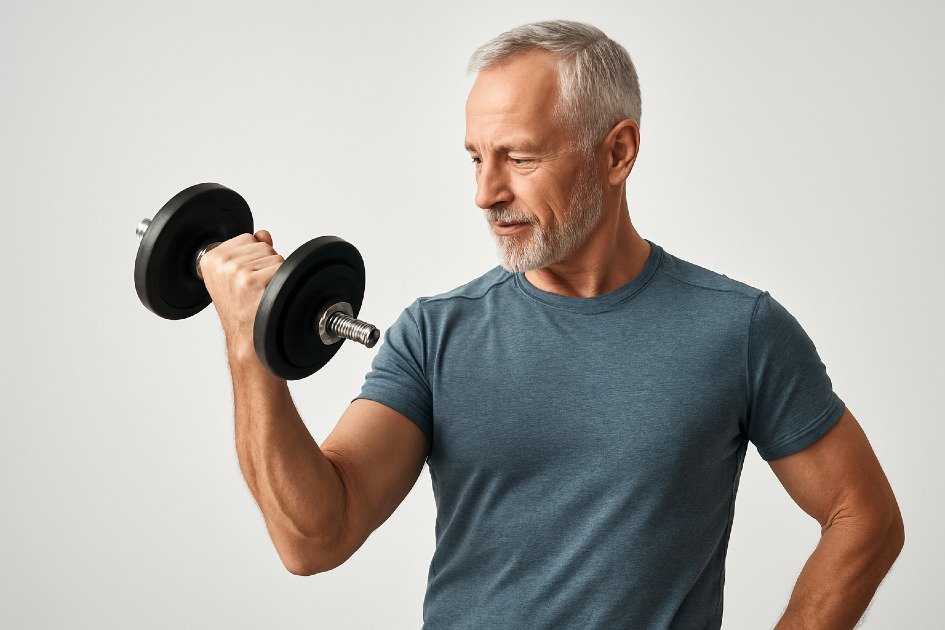
Strength Training for a Stronger, Longer Life
Strength training is essential for longevity, as it helps reverse the decline in muscle mass, bone density, and metabolic efficiency as we age, ensuring strength, mobility, and independence.
Why Muscle Strength Matters for Longevity
Why it matters:
Strength training enhances independence, prevents chronic illnesses, boosts metabolism, and supports mental health by reducing stress hormones and enhancing mood through endorphin release.
How to do it:
- Begin with bodyweight moves like squats or push-ups, then slowly add weights.
- Keep correct form: focus on technique, not weight, to avoid injuries.
- Use resistance bands or dumbbells for strength.
- Do strength workouts 2–3 times a week and rest a day between to let muscles recover.
- Log your reps, sets, and weights to watch your progress grow.
Core Strength: The Unsung Hero of Longevity
Why it matters:
Core strength improves balance, stability, joint health, and overall performance by reducing strain on knees, hips, and back during daily movement and amplifying workout results.
How to do it:
- Planks: Begin with 20–30 seconds and slowly extend the time.
- Bridges: Raise your hips on your back to work your glutes and lower back.
- Bird-dog: Strengthen balance and spine by stretching opposite arms and legs.
- Russian twists: Work your obliques, with or without light weights.
- Consistency: Add core exercises to every workout for stronger results.
Lower Body Strength: Foundation for Longevity
Why it matters:
Strong legs improve balance, reaction time, and metabolism, making daily tasks easier and reducing fall risk.
How to do it:
- Squats and lunges: Master each move with control. Begin with body weight, then add resistance.
- Step-ups: Step on a strong bench to strengthen your thighs and glutes.
- Calf raises: Boosts ankle strength and improves blood flow.
- Leg press or resistance band exercises: Try leg presses or resistance bands to strengthen your legs and boost overall fitness.
Upper Body Strength: Vital for Daily Tasks
Why it matters:
Improves daily tasks like grocery shopping and household chores, reduces shoulder and neck pain, and enhances bone density to prevent age-related bone loss.
How to do it:
- Push-ups: Use knees or an incline to fit your fitness level.
- Dumbbell presses: Strengthen shoulders and chest while boosting joint movement.
- Rows and pull exercises: Build strong back muscles and improve posture.
- Tricep dips: Use a chair or bench to do simple exercises that build strong arms.
- Consistency: Switch between upper and lower body exercises for balanced strength
I have learned that combining strength training with cardio helps me stay healthier and live longer. I keep my workouts short, add resistance little by little, and track my progress. Most of all, I prioritize recovery.
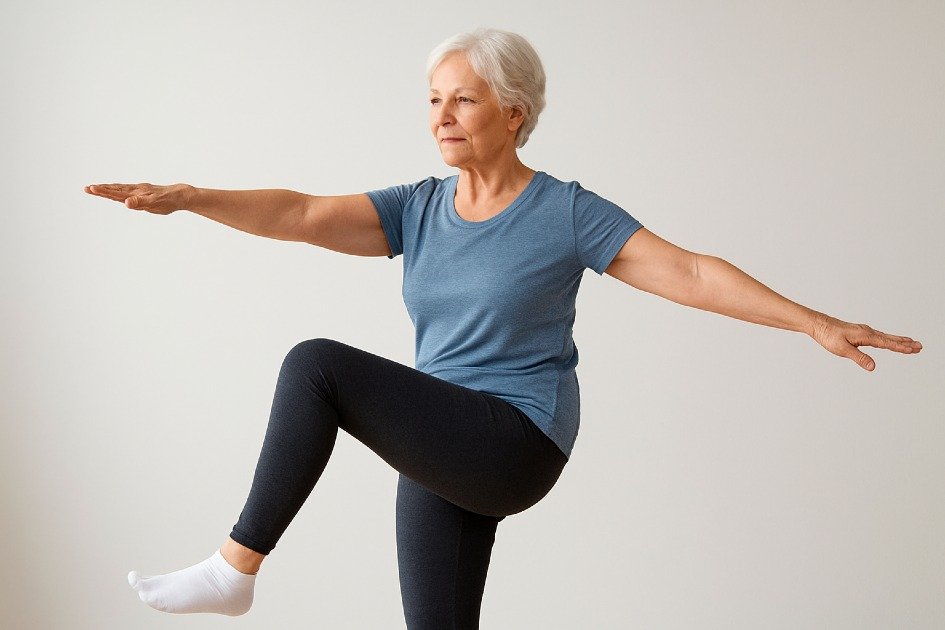
Flexibility and Balance Exercises That Prevent Falls
Flexibility and balance exercises are crucial for preventing falls, improving mobility, and promoting independence as you age. Incorporating these into your daily routine strengthens your body’s stability.
Yoga Poses That Improve Posture and Longevity
Why it matters:
Poor posture increases joint and spine stress, increasing falls and chronic pain. Yoga improves body awareness, core strength, and flexibility, promoting safe movement.
How to do it:
- Mountain Pose (Tadasana):
- Stand straight with feet hip-width apart.
- Tighten your core and lengthen your spine upward.
- Breathe deeply while holding for 30 seconds.
- Build strong legs and better posture for balance.
- Tree Pose (Vrksasana):
- Stand on one leg and rest the other foot on your inner thigh or calf
- Place hands on your chest or lift them overhead.
- Hold each side for 20–30 seconds.
- Improves balance and builds strong ankles.
- Downward Dog (Adho Mukha Svanasana):
- Begin on hands and knees, then lift your hips to form an upside-down V
- Keep your heels down and spine straight.
- Stay in position for 20 seconds.
- Improves flexibility by stretching hamstrings, calves, and shoulders.
I add these poses to my daily workouts to grow my balance, ease stiffness, and move with more confidence.
Pilates for Core Strength and Joint Protection
Why it matters:
A strong core stabilizes the body, reducing falls and injuries, while Pilates targets deep muscles that traditional workouts often overlook, enhancing coordination.
How to do it:
- The Hundred:
- Lie on your back, raise your head and shoulders, stretch your arms, and pump them.
- Tighten your core and keep a steady breath.
- Do one hundred pumps.
- Strengthens core muscles for better balance.
- Leg Circles:
- Lie on your back, lift one leg, and draw slow circles in the air.
- Change sides and do it with the other leg.
- Boosts hip flexibility and build stabilizing strength.
- Pilates Roll-Up:
- Lie flat, stretch arms up, then roll up and reach for your toes.
- Roll down slowly with control.
- Boosts spine flexibility and builds core strength.
I pair these exercises with my other workouts to keep my routine balanced. They are gentle on my joints and help me move more freely every day.
Tai Chi: Ancient Wisdom for Modern Longevity
Why it matters:
Tai Chi, a slow, controlled martial art, enhances body awareness, balance, reduces fall risk, lowers stress, improves flexibility, and improves coordination.
How to do it:
- Basic Tai Chi Step:
- Stand with your feet shoulder-width apart.
- Step forward while shifting weight to one foot.
- Swing your arms as you walk.
- Start with 5–10 minutes and add more time slowly.
- Wave Hands Like Clouds:
- Step side to side and circle your arms at chest level.
- Bend your knees slightly and tighten your core.
- Boosts side-to-side balance and body rhythm.
I spend just a few minutes each day on balance exercises, and I move through daily tasks with more confidence and safety.
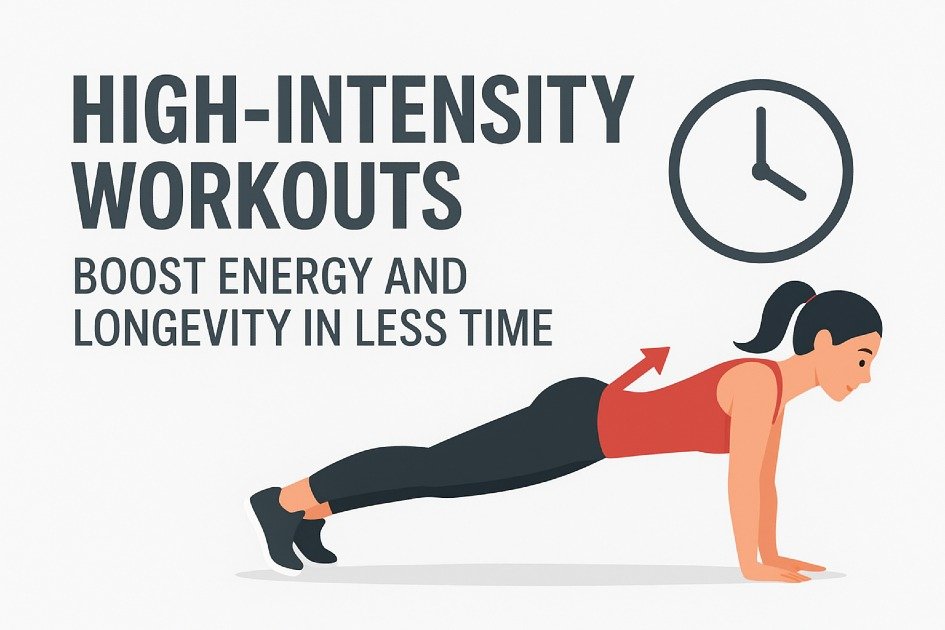
High-Intensity Workouts: Short on Time, Big on Life
High-intensity workouts enhance cardiovascular health, metabolism, insulin sensitivity, and overall vitality without gym time, requiring short bursts of exercise for safe and effective incorporation.
Interval Training: Maximize Heart Health in Minimal Time
Why it matters:
Intense interval training boosts cardiovascular system strength, improves VO2 max, aids weight management, and reduces chronic disease risk by burning more calories in less time.
How to do it:
- Start with 5 minutes of brisk walking or light jogging to get your body ready.
- Sprint, cycle, or jump rope at near-maximum effort for 30 seconds.
- Rest for 60 seconds by walking slowly or cycling gently.
- Do 6–10 rounds, based on your fitness level.
- Stretch for 5 minutes after exercise to keep muscles flexible and prevent stiffness.
I begin with short intervals and slowly add more as my stamina grows. I drink water and eat right to get the best results.
HIIT: Quick, Effective, and Fun
Why it matters:
HIIT enhances insulin sensitivity, regulates blood sugar levels, increases metabolic rate for extended periods, and enhances endurance, making workouts accessible for busy lifestyles.
How to do it:
- Pick 4–6 exercises such as burpees, mountain climbers, or kettlebell swings.
- Give each exercise you are all for 20–40 seconds.
- Pause 10–20 seconds between each exercise to recover and stay strong.
- Do 3–5 rounds, based on your fitness level.
- Finish with stretches and deep breaths to calm your heart.
I get a full workout in just 15 minutes of HIIT at home. I use simple tools like resistance bands or dumbbells to make every move count.
Tabata Training: Supercharged Short Workouts
Why it matters:
Tabata is a method that involves 20-second bursts of intense activity followed by 10 seconds of rest, promoting growth in both aerobic and anaerobic systems without exhaustion.
How to do it:
- Choose one exercise per Tabata session, like squats, push-ups, or kettlebell swings.
- Put in a maximum effort for 20 seconds, then rest for 10 seconds.
- Do eight rounds—4 minutes per exercise.
- Do 2–3 exercises for a full 12–15-minute workout.
I tailor my Tabata workouts to my fitness level to stay safe. I control the intensity and use a timer app to keep every interval precise.
Circuit Training: Strength and Cardio in One Go
Why it matters:
Circuit training combines strength and cardiovascular workouts for total-body benefits, promoting fat loss and muscle preservation, while keeping workouts varied and mentally engaging to prevent boredom.
How to do it:
- Pick 5–7 exercises that work different muscles, like squats, push-ups, and rows.
- Do each exercise for 30–60 seconds with little rest.
- Go straight to the next exercise.
- Do 2–4 rounds based on your energy and fitness.
- Finish with stretches to cool down and reduce muscle soreness.
I combine bodyweight exercises with equipment like a jump rope or kettlebell to keep my workouts fresh and burn more calories.
Safety and Progression: Avoid Overtraining While Gaining Years
Why it matters:
High-intensity workouts can cause injury if overdone, but proper rest and recovery aid muscle repair and growth, while gradual progression ensures consistency and longevity without burnout.
How to do it:
- Do high-intensity workouts only 3–4 times each week.
- Do light workouts like walking, yoga, or stretching on alternate days.
- Track your heart rate, energy, and recovery daily.
- Roll or stretch to ease muscle soreness.
I pay attention to my body. I stick to short, regular workouts because they give me better results than rare, intense sessions. This keeps my energy steady, reduces injury risk, and helps me build lasting strength.
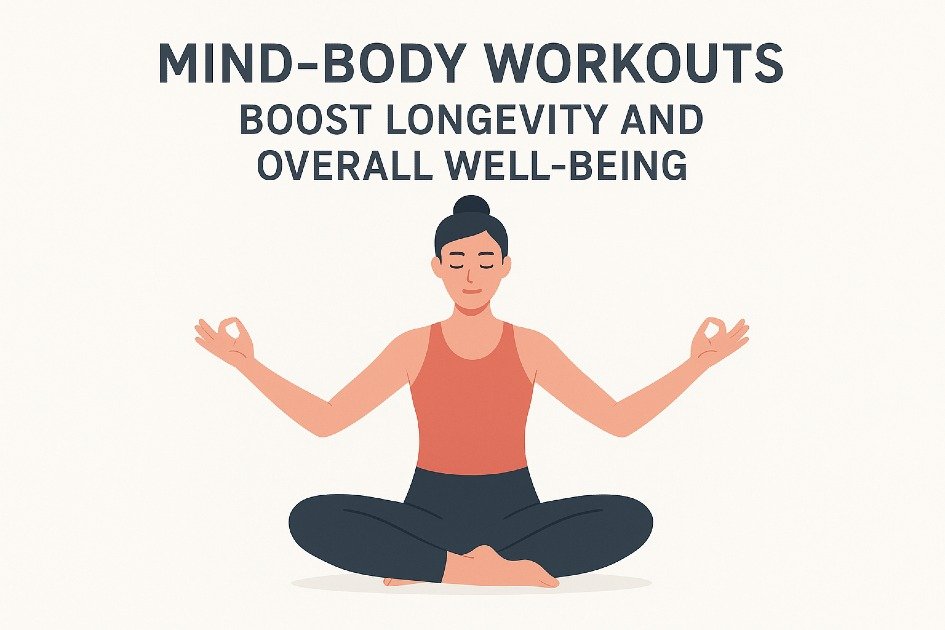
Mind-Body Workouts That Extend Your Life
Modern life’s fast, noisy, and stressful lifestyle often overlooks the importance of mind-body workouts. These exercises not only move muscles but also calm the mind, reduce stress, and improve long-term health.
Meditation-Infused Movement
Why it matters:
Mindfulness promotes heart health, mental clarity, and cellular longevity by regulating stress hormones like cortisol, which inflame the body and weaken the immune system.
How to do it:
- Try a 5–10 minute guided meditation before your workout to focus your mind.
- Breathe deeply and fully with every movement.
- Do slow exercises like yoga or Pilates while visualizing energy moving through your body.
- Increase meditation time slowly as you get comfortable.
I add small mindfulness steps to my workouts, and it turns every exercise into a boost for my health and long life.
Breathwork Exercises
Why it matters:
Breathing properly boosts muscle and brain oxygen levels, improves endurance, and reduces anxiety, while oxygen-rich blood repairs tissues and supports organ function, influencing lifespan.
How to do it:
- Breathe deeply with your stomach: place a hand on it, inhale so it rises, then exhale slowly.
- Practice box breathing—inhale four, hold four, exhale four, hold 4—before or during workouts.
- Breathe deeply while moving slowly, like in tai chi or walking meditation, to boost mindfulness and calmness.
- Track your daily breathing with a timer or app for just 5 minutes.
I focus on my breathing during workouts. It lowers my stress, boosts my energy, and makes exercising more effective and fun.
Yoga for Longevity
Why it matters:
Yoga improves flexibility, strengthens core muscles, calms the nervous system, lowers inflammation, improves joint health, and reduces risk factors for heart disease and chronic illness.
How to do it:
- Try gentle moves like sun salutations or simple seated stretches.
- Practice balance poses like Tree Pose to stay steady and prevent falls as you get older.
- Twist and stretch your spine to ease back tension and boost circulation.
- Exercise 3–5 times a week, even for just 15–20 minutes.
As I practice yoga regularly, it stops just being exercised. It has becomes my daily ritual, keeping my body strong and my mind calm for years to come.
Tai Chi: Ancient Wisdom for Modern Life
Why it matters:
Tai Chi enhances balance, reduces stress, strengthens muscles, lowers blood pressure, improves cardiovascular health, and supports mental sharpness.
How to do it:
- Master simple Tai Chi moves with slow, smooth motions.
- Shift your weight smoothly and move gracefully between poses.
- Match your movements with your breath for calm and focus.
- Practice in a calm space or outdoors to boost your mental wellness.
I practice Tai Chi because it gives me gentle, low-impact workouts that strengthen my body and support long-term health.
Combining Mindfulness with Strength or Cardio
Why it matters:
Mindfulness can enhance performance, prevent injuries, and improve mental state in even traditional workouts by promoting awareness of movement.
How to do it:
- Focus on each muscle as you lift, not on rushing through sets.
- While walking, jogging, or cycling, stay aware of your surroundings, match your breath to your steps, and keep good posture.
- Pause between sets to feel your body and spot tension or discomfort.
- Raise workout intensity slowly while staying calm and focused.
I focus on mindful strength and cardio workouts, which boost my body and clear my mind, making every session more effective and rewarding.
Daily Mind-Body Micro Workouts
Why it matters:
Daily mind-body workouts can significantly improve circulation, mood, energy, and reduce stress without the need for long hours of exercise.
How to do it:
- Stretch for 5 minutes each morning, focusing on your breath and posture.
- Take 2–3 -mindfulness breaks while working or doing chores.
- Do chair yoga or simple stretches if moving is hard
- End your day with deep breathing or guided relaxation to sleep better.
I stick to daily mind-body exercises, even small ones, because each day adds to a longer, healthier life.
Recap: Make Every Workout Count Towards a Longer Life
Consistent workouts are essential for a healthier future. They do not only strengthen the heart but also sharpen the mind and rejuvenate the body.
A variety of workouts stimulate every system in the body, strengthening cardiovascular resilience, preserving muscle and bone density, and preventing injuries.
Mind-body routines like Tai Chi or breath-focused yoga also enhance mental clarity and reduce stress. Small victories, such as micro-workouts and stretch breaks, can be powerful.
When combined with proper nutrition and recovery strategies, workouts become a holistic blueprint for longevity.
Embrace the variety, cherish the process, and make each moment of physical activity count. Your journey to a longer, stronger life starts now.
Frequently Asked Questions
How often should I do workouts to see real longevity benefits?
To maximize longevity, aim for 150-300 minutes of moderate workouts per week, or 75-150 minutes of vigorous activity, incorporating cardio, strength, and flexibility to stimulate the cardiovascular system, preserve muscle mass, and maintain mobility.
Are some workouts unsafe as I age?
Exercises like high impact plyometrics or heavy lifting can increase risk if performed incorrectly. Instead, focus on low-impact exercises like swimming or resistance band exercises. Consult a healthcare professional before starting new workouts.
Can short, 10–15-minute workouts really extend life?
Studies show that even brief, high-intensity workouts, known as “micro-workouts,” can improve heart health, insulin sensitivity, and mitochondrial function, providing significant longevity benefits.
How do I balance cardio, strength, and flexibility workouts effectively?
A weekly plan should include cardio sessions for heart and lung health, strength training for muscle preservation, and flexibility and balance workouts like stretching, yoga, or tai chi for mobility and fall prevention.
What is the best time of day to do workouts for longevity?
Choose consistent time for workouts, considering factors like metabolism, mental clarity, strength, endurance, stress reduction, and sleep improvement. Choose a time that aligns with your natural energy patterns for a long-term routine.
How can beginners start safely without feeling overwhelmed?
Start with low-intensity exercises like walking or yoga, gradually increase intensity, use beginner programs, and warm-up/cooldown to prevent injuries and allow body adaptation.
Do I need a gym or special equipment to add years to my life?
Longevity workouts can be done with minimal equipment, including bodyweight exercises like squats, push-ups, lunges, and core movements, and can be boosted with dumbbells, resistance bands, or kettlebells.
Can workouts reverse aging effects or just slow them?
Workouts slow aging by improving cardiovascular function, preserving muscle mass, and enhancing cellular repair mechanisms. Consistency with nutrient-dense anti-inflammatory foods is key for optimal results.
How does exercise impact mental health and brain longevity?
Workouts boost neurotrophic factors, improve cognitive function, reduce stress hormones, enhance mood, and potentially lower neurodegenerative disease risk. Mind-body workouts like yoga and tai chi enhance mental and physical longevity.
What role does nutrition play in supporting my workouts for long life?
Nutrition plays a crucial role in workouts and recovery, focusing on lean proteins, complex carbohydrates, healthy fats, and endurance support. Combining workouts with targeted supplements can optimize performance and recovery.

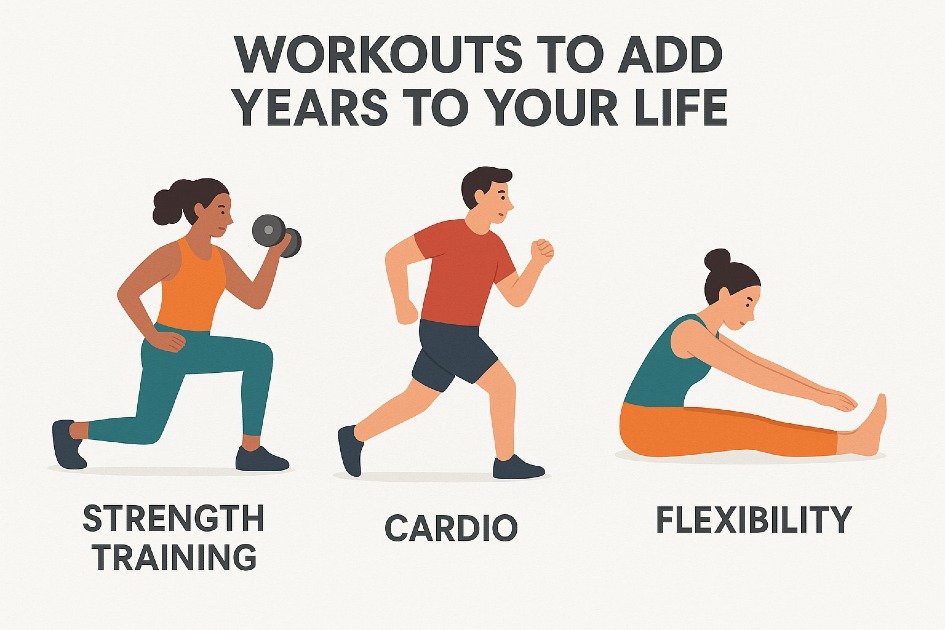
Создание авто mailsco.online с создания. Остаётся лишь смотреть за направлениями авто.